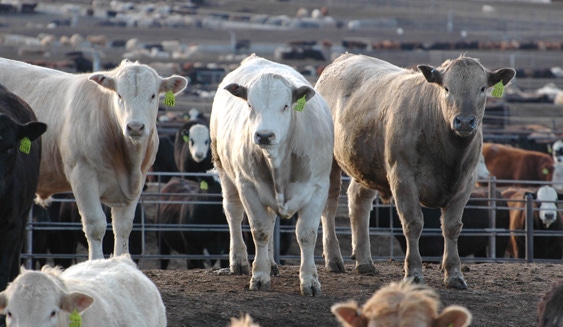Record-high cattle and beef prices fueled by tightening cattle and beef supplies are going to challenge beef demand.
December 27, 2011

"Beginning with December 2009 prices for 750-800-lb. Medium and Large No. 1 Oklahoma City feeder cattle that were 4% above 2008, feeder-cattle prices have exhibited year-over-year increases every month," say analysts in this month's Livestock, Dairy and Poultry Outlook. "Increasingly scarce supplies of feeder cattle, especially heavier, older yearlings, make it likely that feeder-cattle prices will continue high for the next two or three years until calf crops begin increasing year over year. Additional longer-term support for feeder-cattle prices will come as the expected lower corn and feed prices materialize in 2012-13."
David Anderson, a Texas AgriLife Extension livestock economist, emphasized at the recent Brock Faulkner-Brazos Valley Fall Cattleman's Clinic that tight cattle supplies relative to demand should continue fueling historically high cattle prices in 2012.
Anderson projects 2012 prices for 600-lb. steers are $131-$138/cwt. during the first quarter, $136-$144/cwt. in the second quarter, $137-$147/cwt. in the third quarter, and $133-$143/cwt. in the fourth quarter.
Meanwhile, Anderson notes that slaughter-steer prices hit a high of $125/cwt. in April and a low of $105/cwt. in June. Scattered fed-cattle sales last week were reported as high as $126.50 in the Northern Plains.
"Despite the high fed-cattle prices, profit margins have stayed at breakeven levels or lower, in some cases much lower," LDPO analysts say. "In addition, cattle feeders continue to place expensive feeder cattle in anticipation of higher fed-cattle prices in 2012, when supplies of fed cattle are expected to become scarce. However, fed-cattle supplies will likely continue at or near current levels until sometime during the first half of 2012 because of the large numbers of lightweight feeder cattle that were placed on feed during the last half of 2011."
Now, consider what all that means in terms of beef production.
Derrell Peel, Oklahoma State University Extension livestock marketing specialist, projects a 3-4% decrease in beef production in 2012 and 2013. "That's a sign this industry has simply reached a point where it can't maintain production with the number of animals we have left," he explains.
Speaking at the recent University of Nebraska Beef Short Course, Peel said he expects the Jan. 1 beef cow inventory to be about 3.5% less than a year earlier, the smallest herd since the early 1960s. "That speaks to the challenge we are having in the coming years to rebuild the industry to some level that matches demand," Peel says.
Analysts with the Livestock Marketing Information Center (LMIC) says, that in 2010, per-capita retail weight consumption of beef was 59.6 lbs., down 1.5 lbs. from 2009. This year, it's projected to be 57.5 lbs., the smallest since before 1955. U.S. per-capita beef consumption peaked at 94.6 lbs. in 1976.
LMIC analysts explain that per-capita consumption is annual beef production (adjusted for imports and stocks in cold storage) divided by the U.S. population.
"U.S. per-capita beef consumption isn't the same as beef demand; consumption is just one of two important components of the domestic demand relationship," LMIC analysts say. "Demand is a relationship that also incorporates a price dimension. Aggregate consumer demand for beef calculations use U.S. per-capita retail sales weight and a calculated inflation adjusted retail beef price by USDA's Economic Research Service based on data collected to calculate the national Consumer Price Index. According to those quarterly indexes, year-over-year domestic consumer beef demand has improved slightly but remains below pre-recession (i.e., 2008) levels."
"Only in recent weeks have we seen what appears to be stronger domestic demand for middle meats," Peel adds. "We've had a ground beef-oriented demand since this nation entered the recession and it persists to this point."
Growing demand is essential given the way prices will challenge consumers.
"We're going to put more pressure on wholesale and retail beef prices. Beef demand will ultimately determine the limit on how high prices can go," Peel says. "The supply situation suggests prices can go as high as demand will support."
About the Author(s)
You May Also Like



.png?width=300&auto=webp&quality=80&disable=upscale)
.png?width=300&auto=webp&quality=80&disable=upscale)
